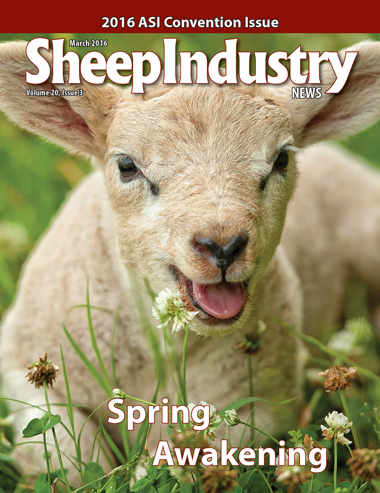
- March 2016
- President’s Notes
- 2016 ASI Convention
- The Strength of a United Voice
- State Execs Benefit from Media Training
- Award Winners Recognized
- Producer Panel Praises EBVs
- PERC Hears Survey Results
- Tips on Preparing for VFD
- Providing Consistent, Quality Lamb
- Let’s Grow Sets New Priorities
- Allotment Records Are Important
- Legislative Council Busy in 2015
- Next Generation Makes Plans
- Arizona Ag Tour
- Optimism For Wool Industry
- Make It With Wool Winners
- Working Dog Liability Insurance
- Seeking Young Producer for Tri-Lamb
- Wolf Testifies on Behalf of Sheep
- Sheep Inventory Up Again
- Use NSIP Data To Improve Lambing Rates
- Market Report
Providing Consistent, Quality Lamb
CAT URBIGKIT
Special to the Sheep Industry News
A joint meeting of the Lamb Council and the American Lamb Board drew a full house during the annual convention in Scottsdale.
Erica Sanko of the California Wool Growers Association gave an update on recent progress in USDA’s Agricultural Marketing Service Livestock Mandatory Reporting regulations, noting that the program reauthorization last fall included new provisions requested by the industry to better reflect current industry structure and marketing practices. These changes resulted in the addition of several new reporting parties, providing more transparency into the market.
Although LMR now includes a category for pelt prices, this information is provided voluntarily and is not mandatory. Since the price reported is the value paid by packers to producers for slaughter lambs, rather than the pelt price paid by pelt processors/wholesalers, the Agricultural Marketing Service is seeking feedback on the usefulness of this information to the industry, Sanko reported.
Looking forward, Sanko said that new LMR lamb regulations will be published in March that include a “lambs committed” category that would capture transactions for lambs to be processed in the future.
Karissa Maneotis of Colorado State University focused on the national lamb quality audit and resulting research. The audit found that the American consumer tends to think of sheep in lush pastures, eating grass. Lamb is viewed as an environmentally friendly protein product, with premiums offered for “all natural, no hormone” products.
Maneotis reported that research indicates retailers would pay for consistency, for guaranteed quality – with 71 percent reporting they would pay a premium for guaranteed quality. CSU is now conducting a lamb flavor study designed to establish a “proof of concept” for differentiating lamb flavors (using mild, medium and strong or bold categories, and muttony and pastoral classifications). The research involves volatile flavor compound analysis and olfactometry. Results should be available later this year.
D. Macdonald Wick & Jerad Jaborek of Ohio State University gave an update on OSU’s research designed to identify factors that affect sheep meat flavor. Jaborek is using a machine to identify four compounds associated with sheep meat flavor. Three branched-chain fatty acids are responsible for muttony flavors, while another compound is responsible for what is defined as a pastoral flavor.
Jaborek is also investigating effects of diet, sex and maturity on performance. He found that wethers had greater final weights compared to ewe lambs, and wethers also consumed more feed than ewe lambs.
Lambs fed on an ad lib whole shell corn diet had greatest average daily gains and more pounds of gain per pounds of feed, compared to alfalfa and limit-fed lambs. WSC-fed lambs produced carcasses with greater backfat and bodywall thicknesses compared to lambs fed alfalfa pellets. WSC-fed lambs produced carcasses with greater marbling scores and yield grads than lambs fed alfalpha pellets.
Texas A&M’s David Anderson, Ph.D., provided an update on the lamb market outlook, noting that there is an all-time high of lamb in cold storage (30 days or longer in refrigerated warehouses, consisting of all lamb, not just American lamb), but that is also the current state with other livestock meats.
On the positive side, lamb and yearling dressed weights at federally inspected slaughter facilities are reduced from a year ago, with an average dressed weight of 75 pounds, getting away from the overfinishing issue that plagued the industry last year.
Anderson said he expects to see an increase in American lamb production in the next two years. With the largest frozen stocks in history, combined with a large increase in imports, the industry has to work off the burdensome level of stocks available to the market. It remains to be seen how that will work itself out, Anderson said.
Anderson is also working to develop cost of production budgets that reflect conditions in various regions of the United States, as well as a national budget that is a weighted average of these individual budgets. The budgets are for conventional sheep production, based on the state average flock sizes, with receipts and costs on a per-head basis.

